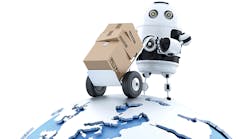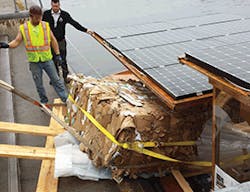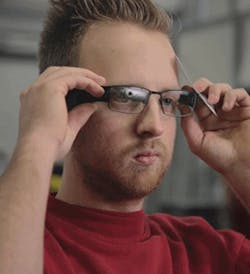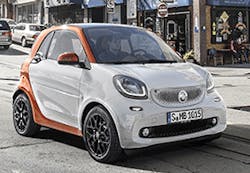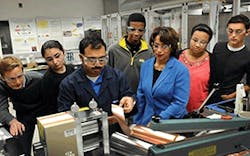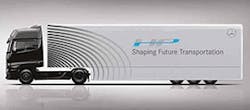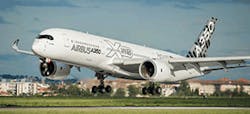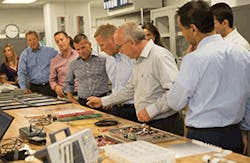MH&L's Innovation Awards 2015: Top 10 Supply Chain Innovations of the Year
Welcome to the 2015 MH&L Innovation Awards, an annual tradition celebrating advances in technology, processes, workforce management, and varied and sundry other supply chain best practices. In the following pages, we'll revisit some of the most popular stories that appeared on our website, our various social media channels and newsletters. We've retained the original headlines in case you'd like to go online to read our original reports for more details.
Enjoy this extra-long feast of award-winning excellence, and if the evidence here is an accurate predictor of the future, 2016 should prove to be another amazing year of supply chain innovations.
MARITIME TRANSPORTATIONSolar Vessel Carries Cargo across Erie Canal
The boat is said to have performed well, despite significant overcast and rain for several days. Solar Sal reached her top speed of 7 knots when called for, and in direct sunlight could sustain a 5-knot cruising speed (same as commercial tugs travel in the canals) using only 4kW of power.
The vessel runs at its peak performance using only half power, and its onboard batteries can hold enough charge for an additional 50-mile run after dark.
Since the solar arrays can deliver 5kW on a sunny day, a reasonable speed can be achieved while more energy flows into the boat's batteries than it is using—in essence the boat is refueling while underway.
Solar Sal can accommodate up to a 12-ton payload.
FLEET MANAGEMENTA Robot Dispatcher to Help Truck Drivers Avoid Disruption
The MIT Computer Science and Artificial Intelligence Laboratory (CSAIL) is developing an automated travel advisor that could ultimately function as a type of robot dispatcher that helps truck drivers avoid disruptions and choose the optimum routes to their destinations.
The algorithm will show the acceleration profile of the vehicle so the driver can anticipate features such as hills, and adjust the route to meet their deadlines.
The system has speech-recognition technology that enables it to establish a dialogue with the driver. It might ask what the driver's goals are for a trip, and automatically plot the most time- and fuel-efficient route based on the latest traffic information and digital maps.
Unexpected changes can also be taken into account. For example, if the driver wants to travel to a restaurant and the place is closed, the advisor can be programmed to suggest other options.
WAREHOUSE MANAGEMENTGoogle Glass Helps Warehouse Workers See Better
In January the company completed a pilot project testing smart glasses and augmented reality in a warehouse in the Netherlands. In cooperation with office products manufacturer Ricoh and wearable computing solutions expert Ubimax, the technology was used to implement vision picking in warehousing operations.
Staff was guided through the warehouse by graphics displayed on the smart glass to speed up the picking process and reduce errors.
For three weeks, warehouse staff were equipped with head-mounted displays such as Google Glass and VuzixM100. The displays showed the respective task information during the picking process, including aisle, product location and quantity. Overall, 10 order pickers used the equipment and picked more than 20,000 items, fulfilling 9,000 orders within the given time frame. As a result, staff was able to operate much faster and error-free. Currently DHL and Ricoh are jointly evaluating the roll-out of the solution.
The pilot proved that augmented reality offers added value to logistics and resulted in a 25% efficiency increase during the picking process.
AIR TRANSPORTATIONWorld's Largest Self-Ballasting Cargo Airship under Development
In September, the Aeroscraft Corp. (Aeros) announced it has developed a vertical takeoff and landing-capable heavy-lift cargo ship, known as the ML866 (66-ton). The aircraft, which somewhat resembles a blimp, is a variable-buoyancy cargo airship featuring an onboard buoyancy management system, rigid structure, vertical takeoff and landing performance, and operational abilities at low speed, in hover, and from unprepared surfaces.
The goal of the project is to dramatically decrease the time and cost for delivering container cargo around the world, especially to austere areas with no pre-positioned infrastructure. Aeros hopes to achieve FAA operational certification for the first deployable Aeroscraft within five years.
Aeros hopes to complete the configuration ‘design freeze' for the 66-ton payload capable Aeroscraft by the end of 2015 as part of fleet development efforts now underway to satisfy global demand for the vehicle's new logistics capabilities.
SUPPLY CHAIN NETWORK OPTIMIZATIONMercedes Reorganizes Its Supply Chain Network to Reduce Auto Costs
Part of Mercedes' strategy involves the opening of a new consolidation center in Germany, which will provide highly specialized logistics services. Once that center becomes fully operational in 2016, it will ship several hundred cargo containers per week via inland waterways or by rail. Those containers will then be loaded onto freighters and transported to China, South Africa and the United States.
Previously, logistics service providers were solely responsible for managing shipments of materials from German and European suppliers to Mercedes' plants overseas. The new arrangement will not only be shorter in distance but will also greatly reduce the company's carbon emissions.
Mercedes also plans to focus on optimizing material flows into its production facilities—from material deliveries to component installation in vehicles. One plant, for instance is piloting a project in which materials used in the final assembly area are exclusively brought to the line in prepackaged baskets by driverless transportation systems, eliminating the need for workers to get the materials themselves.
The company has also begun construction of a new network hub at an Adriatic seaport to ship vehicles to Asia.
TALENT MANAGEMENTFord Motor Builds Own Talent Pipeline in Detroit
In May, Ford Motor Co. announced that it plans to establish four career academies in Detroit to train future engineering, manufacturing and IT professionals. The academies will serve up to 1,400 students.
Ford currently has four academies in three locations—Volusia County, Fla., Louisville, Ky., and Utica, Mich. When the Detroit academies are added, the network will be serving 2,800 students.
By 2020, Ford expects to have 20 academies serving 7,000 students in cities where the company has assembly plants, as well as elsewhere in the U.S.
The academies are a combined effort involving Ford's STEM educational programs and its national Next Generation Learning (Ford NGL) initiative. Ford NGL, which was launched in 2006, provides financial support, coaching, mentoring and technical support to 20 communities in the U.S.
Academy students continue to attend their regular high schools, but instead of participating in general classes, they learn standards-based core academics through projects grounded in engineering, IT and manufacturing.
MOTOR CARRIERSSelf-Driving Truck Hits the Highway
The standard Mercedes-Benz Actros, fitted with the intelligent Highway Pilot system, traveled about nine miles on the A8 motorway, with a driver in the cabin but his hands off the wheel.
The Highway Pilot is comparable to a plane's autopilot in that it can steer the truck by itself, but a human driver is still needed to monitor traffic conditions and be ready to take over at a moment's notice.
Daimler admits that a completely autonomous truck, without a human co-pilot, is still a long way off.
ADDITIVE MANUFACTURINGAirbus Using 3-D Printed Flight Parts to Increase Supply Chain Flexibility
The parts are 3-D printed using thermoplastic resin certified to an Airbus material specification. The resin provides high strength-to-weight ratio and is FST (flame, smoke and toxicity) compliant for aircraft interior applications. This enables Airbus to manufacture strong, lighter weight parts while substantially reducing production time and manufacturing costs.
The use of additive manufacturing has also enhanced the buy-to-fly ratio, since far less material is used than with conventional manufacturing methods.
SUPPLIER MANAGEMENTNissan Plans Supplier Park in Tennessee
In March automaker Nissan North America announced it plans to invest $160 million to build a new supplier park at its Smyrna, Tenn., vehicle assembly plant. The project, expected to be completed in 2017, aims to create and support more than 1,000 supplier jobs.
Establishing the supplier center will allow Nissan to lower both its inbound and outbound logistics costs, which in turn will lead to better productivity, efficiency and quality, the company expects.
In 2014, the Smyrna plant assembled more than 648,000 vehicles, and by the end of 2015, 85% of all Nissan vehicles sold in the U.S. will be built in North America. The Smyrna plant assembles the Nissan Altima, Maxima, all-electric LEAF, Rogue crossover, Pathfinder SUV and Infiniti QX60 luxury crossover.
INTERNET OF THINGSCardinal Health Taps the IoT to Improve Medical Supply Chain
The new, 20,000 sq. ft. lab will serve as a hub for Cardinal Health to explore new approaches, such as smart sensors and near-field communication, to bring creative, acute care-centered technologies to the healthcare field. The R&D lab will also take aim at reducing or eliminating the estimated $5 billion in wastes throughout the medical device and implantables supply chain.
Cardinal Health plans to expand its automated inventory management offerings and solutions for challenging processes related to procedural areas, such as the operating room. The company's inventory management solutions are currently used to track products in more than 2,700 hospital locations and 68 distribution locations worldwide.
